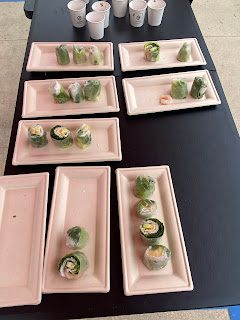It's the first week of June, and while LA's annual June gloom still occasionally spoils our sky's-out thighs-out aspirations, the punishingly hot dog days of summer are just around the corner at East Hollywood Community Garden.Accordingly, it's the perfect time to ready a no-oven recipe to keep kitchens cool, just like this one for Vietnamese Summer Rolls, which takes advantage of the multitude of herbs available at the garden. The recipe also features crisp and refreshing cucumbers—a summer garden staple—and those leafy greens still hanging around from our winter/spring gardens.
Serves 2 as a complete meal, 6 as an appetizer
Total Time: 30 minutes
Ingredients:
For the rolls
6 sheets of rice paper
1/2 lb rice vermicelli
6-8 leave of romaine lettuce
1 bunch of cilantro and/or mint
2 persian cucumbers, sliced lengthwise into 6 inch sections
1/2 lb boiled shrimp, sliced pork, or protein of choice
Nước chấm dipping sauce2 tbsp fish sauce
2 tbsp sugar
2 tbsp rice vinegar
4 tbsp warm water
1 clove minced or grated garlic
1 pinch chili flakes (optional)
Peanut sauce (vegan)
4 tbsp creamy peanut butter
2 tbsp hoisin sauce
1/2 cu. warm water
1 clove minced garlic
1 tsp neutral oil
Preparation
Step 1: Start by boiling the noodles according to package instructions and rinse thoroughly with cold water after they're done.
Step 2: While the noodles are boiling, start boiling or steaming whatever proteins you're using separately.
Step 3: Wash, cut, and de-stem whatever vegetables and herbs you're using.
Step 4: After all your fillings are ready, start your first roll by fully wetting the rice paper, shaking off the excess, and placing it on a flat surface.
Step 5: Put your broad leaf green down first on the bottom third of the rice paper, then stack on a pinch of herbs, then your crunchy veg, then a small handful of noodles, then 3-4 pieces of shrimp or pork.
Step 6: Roll up from the bottom about halfway, then fold in the sides, then finish the rolling up the rest.
Step 7: Repeat for the remaining rolls.
Step 8: For the nước chấm, simply mix all the ingredients together.
Step 9: For the peanut sauce, saute the garlic in a small pot on medium-high for about 20 seconds. Add the water and peanut butter and whisk until smooth. Add the hoisin sauce, simmer for one minute, then remove from heat. Adjust thickness to your preference by adding water (too thick) or simmering a little longer (too thin).

- Aside from the rice noodles, filling options are flexible, but there are some basic guidelines: you just need a broad leafed green, a raw eating herb, a crunchy raw veggie, and a protein.
- Make sure you use the sauces, they're what tie all the flavors together!
- Avoid using cooked veggies or herbs that you normally need to cook with, such as sage/oregano/thyme/etc.
- Resist the temptation to boil the noodles and proteins in the same pot. The water gets starchy.
- When rolling, wetting your rolling surface a bit beforehand helps prevent the rice paper from sticking.
- Try not to overstuff the rolls; it’ll tear the rice paper. Better to have 2 undersized rolls than one large one.
- Keep your rolls tight. Loose rolls tend to spill their filling when you start dipping them.
Recipe from Vincent, plot 31.



































